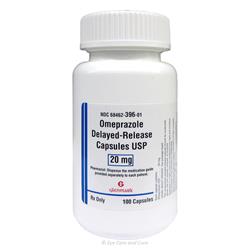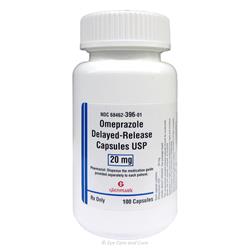Providing Quality & Trust || Clinic Website
Omeprazole Delayed Release Capsule
Glenmark
$0.12 - $11.42
$0.12 Each
Detailed Description
Omeprazole
(oh-meh-prah-zahl)
- Description: Stomach acid reducer/Antacid (Proton Pump Inhibitor)
- Other Names for this Medication: Gastrogard®, Prilosec®
Used to treat or prevent stomach ulcers; usually only short-term. Works bestif given before the first meal of the day. Do not open capsules, break or cuttablets unless instructed to. Talk with your veterinarian or pharmacistif you need a different dosage form.
How is this medication useful?
Omeprazole is a medication thatis used to prevent and/or treat stomach ulcers. The FDA (U.S. Food & Drug Administration) has approved this drug for use in horses and humans. The FDA allows veterinarians to prescribe and use products containing this drug in other animal species in certain situations. You and your veterinarian can discuss why this drug is the most appropriate choice.
Uses/Indications:
Omeprazole is potentially useful in the treatment of both gastroduodenal ulcer disease and prevention or treatment of gastric erosions caused by ulcerogenic drugs (eg, aspirin, NSAIDs). In a study, omeprazole was superior to famotidine when used to prevent exercise-induced gastritis in racing Alaskan sled dogs. When administered at 1.5 – 2.6 mg/kg PO every 24 hours, omeprazole more significantly suppresses gastric acid in dogs as compared with famotidine at 1 – 1.3 mg/kg PO every 12 hours. Omeprazole has been used as part of triple therapy (with clarithromycin and amoxicillin) in the successful treatment of Helicobacter spp infections in dogs. In dogs and rabbits following ventriculo-cisternal or IV administration of omeprazole, a reduction in CSF production has been noted. Although this effect could be useful in the treatment of conditions causing intracranial hypertension (eg, hydrocephalus, syringomyelia), this effect has not been confirmed in healthy dogs after oral administration.
In a study cats, 2 preanesthetic doses of 1.45 mg/kg and 2.2 mg/kg effectively increased gastric and esophageal pH within 24 hours; however, no increase in serum gastrin was noted.
Oral paste products are labeled for use in horses and foals 4 weeks of age and older. The drug effectively treats and prevents gastric ulcers, and is considered the drug of choice of equine gastric ulcer syndrome. Ulcer healing and improvement was much better when omeprazole was used for squamous gastric ulcers than glandular gastric ulcers. Esophageal pH was not significantly altered by omeprazole use under experimental conditions. A preliminary investigation on IM administration of a novel long-acting injectable formulation in horses showed promising results, with intragastric pH above 4 in the majority of the animals up to 7 days. Healing was observed in 100% of horses with squamous disease and in 75% of subjects with glandular disease.
What are the side effects of this medication?
- Omeprazole is generally tolerated well by dogs, cats, and horses, butit could cause vomiting (notin horses), decreased appetite (eating less), excessive gas, and diarrhea.
- There is one report of a horse showing signs of skin itchiness after getting the drug.
You don’t have to be overly concerned if you see any of these signs unless they are severe, worsen, or continue to be a problem. Contact your veterinarian if this happens.
Contraindications/Precautions/Warnings:
Omeprazole is contraindicated in patients hypersensitive to it or other proton pump inhibitors. In patients with hepatic or renal disease, the drug’s elimination half-life may be prolonged, and dose adjustment may be necessary if the disease is severe. Discontinue omeprazole administration in patients with interstitial nephritis. Use for the shortest duration of therapy appropriate to the condition being treated.
Do not confuse PriLOSEC® (omeprazole) with PROzac® (fluoxetine) or OMEprazole with ESOMEprazole or FOMEpizole.
Adverse Effects:
The manufacturer does not note any adverse effects for use in horses at labeled dosages. In foals, calcium absorption may potentially be reduced; clinical significance is not clear. There is an anecdotal case report of one horse developing urticaria after receiving omeprazole. Treatment of horses for up to 90 days is believed to be safe. In a recent study, no adverse effects were reported in horses treated with 12 mg/kg (3 times the maximum recommended dose) for 90 days. No effect was noted on fecal microbiota in research horses given omeprazole (4 mg/kg/day PO) for 28 days.
Omeprazole appears to be well tolerated in both dogs and cats at effective dosages. GI distress (eg, anorexia, colic, nausea, vomiting, flatulence, diarrhea) hematologic abnormalities (rare in humans), proteinuria, and CNS disturbances can potentially occur. Chronic high doses in rats have caused enterochromaffin-like cell hyperplasia and gastric carcinoid tumors; effects occurred in a dose-related manner. The clinical significance of these findings for long-term low-dose clinical use is not known; however, in humans, administration for more than 8 weeks is not recommended unless the benefits of therapy outweigh the potential risks. In dogs, omeprazole therapy is believed to be safe for at least 4 weeks. A small study has indicated that a shift in canine pharyngeal flora may occur during omeprazole therapy, but further studies are needed to determine the clinical significance of this.
In humans, long-term omeprazole use is associated with an increased risk of bone fractures, fundic gland polyps, acute interstitial nephritis, and hypomagnesemia.
Drug Interactions:
In humans, omeprazole is an inhibitor of CYP 2C19, and is a CYP 2C19 and 3A4 substrate. The following drug interactions have either been reported or are theoretical in humans or animals receiving omeprazole and may be of significance in veterinary patients. Unless otherwise noted, use together is not necessarily contraindicated, but weigh the potential risks should be weighed and additional monitoring performed when appropriate.
- BENZODIAZEPINES (eg, alprazolam, diazepam): Omeprazole may potentially alter benzodiazepine metabolism and prolong CNS effects.
- CEFPODOXIME: Serum cefpodoxime concentrations may be reduced.
- CEPHALEXIN: Omeprazole reduced peak cephalexin concentration and AUC, and delayed oral absorption in adult dogs; however, time > MIC was not altered.27
- CLARITHROMYCIN: Increased levels of omeprazole, clarithromycin, and 14-hydroxyclarithromycin are possible.
- CLOPIDOGREL: In healthy dogs, concurrent omeprazole increases formation of an inactive clopidogrel metabolite but without significant alteration of antiplatelet effect.28 Pantoprazole should be considered in place of omeprazole if an interaction with clopidogrel is a concern.
- CLORAZEPATE: Concurrent use with omeprazole may result in an increased risk for clorazepate toxicity.
- CYANOCOBALAMIN (oral; Vitamin B12): Omeprazole may decrease oral absorption of cyanocobalamin.
- CYCLOSPORINE: Omeprazole may reduce cyclosporine metabolism.
- DIGOXIN: Omeprazole may increase digoxin bioavailability, increasing the risk for toxicity.
- DIURETICS (eg, furosemide, hydrochlorothiazide): May increase risk of hypomagnesemia.
- DRUGS REQUIRING DECREASED GASTRIC PH FOR OPTIMAL ABSORPTION (eg, ketoconazole, itraconazole, iron, ampicillin esters): Omeprazole may decrease drug absorption. If both drugs are used together, a pH-dependent medication should be administered 1 hour before omeprazole.
- LEVOTHYROXINE: Concurrent use may decrease levothyroxine absorption.
- METHOTREXATE: Concurrent use may increase methotrexate levels and risk of toxicity.
- MYCOPHENOLATE: Mycophenolate peak concentration and total exposure (AUC) may be reduced.17
- PHENOBARBITAL: Concurrent use may increase risk for phenobarbital toxicity.
- RIFAMPIN: Omeprazole serum levels may be decreased.
- WARFARIN: Omeprazole may increase anticoagulant effect. Prothrombin time (PT) should be monitored in patients on concurrent warfarin therapy.
Powered by nopCommerce
This site is running in live payment mode. Real payments will be processed.

